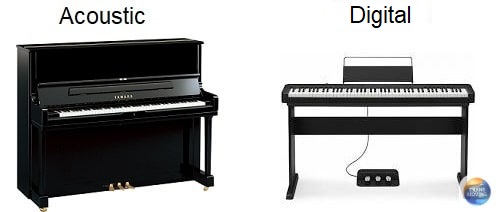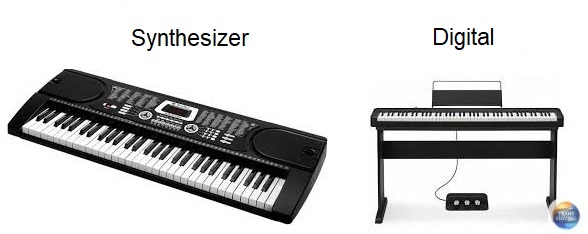Seven questions and answers about choosing a piano for a child from EASY-MOVING
How to choose a piano for a child. What to pay attention to. What is the difference between digital pianos, acoustic and synthesizers?
Free Estimate Online
If a child is interested in music or is studying at a music school, he needs a home instrument. Those who are engaged in the piano class can not do without a piano.
Before buying, there are many questions: what kind of piano to choose, how digital instruments differ from synthesizers, what should be the keyboard and sound.
Which is better: acoustic or digital
Briefly, if there is a place in the apartment, the desire to study professionally and the patience to listen to the child play is acoustic. In all other cases — digital.
Few people are ready to put a large acoustic piano at home, and it is not so easy to find a good one. Often used tools need to be restored, and some are unsuitable for tuning. New acoustic instruments may not be affordable — a good instrument can cost several hundred thousand rubles.
If you still have a place at home and your child plans to study music professionally, you can buy an acoustic piano. The main thing is to choose it with a professional customizer who will assess the instrument's condition.
Or buy a new acoustic piano. Here I advise you to pay attention to the Kawai tools. They will be of excellent quality, and at a price to find an option is also not difficult.
The acoustic instrument is made of natural materials, so it gives a really bright and noble sound. True, such pianos weigh about 150-200 kg. For comparison, a digital piano weighs much less — from 15 to 60 kg.
Many music school teachers still insist on buying an acoustic instrument for teaching. Still, someone has already managed to appreciate the advantages of digital pianos and their sound, so they are willing to advise students on these instruments.
The case of digital instruments is smaller, so they are easy to move around the apartment. One of the advantages is that the digital piano does not need to be tuned.
'Acoustic equipment requires regular tuning-about once every six months, sometimes once every three to four months.
Digital pianos, like acoustic ones, have a full-size keyboard with 88 keys equipped with a hammer mechanism. Only in an acoustic instrument, the hammers hit the strings, and in a digital instrument, they hit the sensors. This is the main difference.
An acoustic piano weighs 330-450 lbs, while a digital piano weighs 10-12 times less, i.e. 33-35 lbs.

How do digital pianos differ from synthesizers?
Briefly, in digital pianos, the hammer-like mechanics of the keyboard are close to acoustic instruments. It is full-sized and suitable for learning to play the piano class.
The synthesizer has different mechanics - the keys are light-and the principle of sound production is also different, so it is not suitable for training. Most often, the synthesizer has a stripped-down keyboard: 61 or 76 keys.
Digital piano and synthesizer belong to the keyboard class, but they are completely different. If a child learns from a synthesizer class, he needs a synthesizer, and if he learns from a piano class - he needs a piano.

If at home, instead of a piano, there is a synthesizer, you will have to retrain and adapt every day in the music school class for a real instrument. You can't replace an acoustic piano with a synthesizer, but you can replace it with a digital piano.
What is the difference between portable and case-based digital pianos?
Briefly, the first is the size. Portable ones are smaller and lighter. The second is the ability to connect three pedals and the original configuration. In the case of pianos, unlike portable ones, three pedals and a stand are already included.
If you plan to carry the instrument often, for example, take it to the country in the summer or take it with you to performances, it is better to buy a portable model. If you only need a piano for your home, you can choose a cabinet instrument.
Portable is a keyboard with 88 keys. The kit usually includes a music stand, a stand for music, a sustain pedal-an analog of the right pedal on an acoustic instrument, and a power adapter and instructions.
The rack for portable tools is always purchased separately. It can be x-shaped metal or wooden. The first ones are universal. That is, they are suitable for any tools.
The latter are suitable only for certain models and are always available for each tool. It is important that the block of three pedals, in most cases, can only be attached to a wooden stand.
The case instrument looks like an acoustic piano. It comes with a stand and a block of three pedals. These tools are designed for the fact that they will be allocated a permanent place in the house.
The dimensions of the case tools vary quite a lot. Here you can find both very compact models and overall ones for those looking for a more classic version of the tool.
What keyboard mechanics are needed
Briefly, the best option is a three—touch hammer keyboard.
Any digital piano has 88 full-size keys with hammer mechanics. The keyboards differ in the number of sensors, the material from which the keyboard is made, and additional technologies that make the keys as identical as possible to real acoustic instruments.
The best option is a mechanic with three sensors. This means that each key has one sensor for pressing, a second for releasing the key, and a third that is triggered when the key is not fully pressed.
Such mechanics will allow you to reproduce a clear sound when playing, for example, a double rehearsal. You can't do this on an instrument with two sensors.
The most affordable piano with three sensors is the Roland FP — 30. Among its analogues in other brands with a small difference in price, I will single out the Casio PX-S1000/S3000.
If we talk about case-based digital instruments with three-touch mechanics, the most budget options will be digital pianos Korg LP-380 and Casio PX-770.
On the Internet, you can find information about such a concept as graduated keys. This means that each key in the instrument has its own weight. The heavier keys are in, the lower case, and the lighter keys are in the upper case.
Graduated mechanics are found only inexpensive tools. In budget models, all keys weigh the same, while their" weight " can be adjusted minimally by settings. Why is polyphony important?
Briefly, it is the polyphony that is responsible for the depth and quality of the sound. The more polyphony, the richer the sound.
Many parameters influence the realistic sound in digital pianos. One of the main ones is polyphony.
Polyphony is the number of simultaneously sounding notes. In digital instruments, polyphony values are found: 48, 64, 128,192, 256. Of course, we are not talking about simultaneously pressing 256 notes.
When playing an acoustic instrument, holding down one key, we hear not only the string that the hammer struck. We hear the vibration of the adjacent strings, which enrich the sound of the played note. The digital piano works the same way.
When a single note is taken, the sound processor produces a palette of several sounds, simulating acoustics' sound. When using the pedal, it adds even more sounds.
When playing with two hands using the pedal, these sounds become very much. That is why polyphony is important: the more sounds an instrument can reproduce, the deeper and richer the sound will be in the end.
Sound processors of all brands are very different, so you should not blindly compare the polyphony of 192 and 256 voices. Both of these values are high and give good surround sound.
It is not a fact that an instrument with a polyphony of 256 voices will sound better than one with only 192. We recommend you to listen and compare the sound before buying









